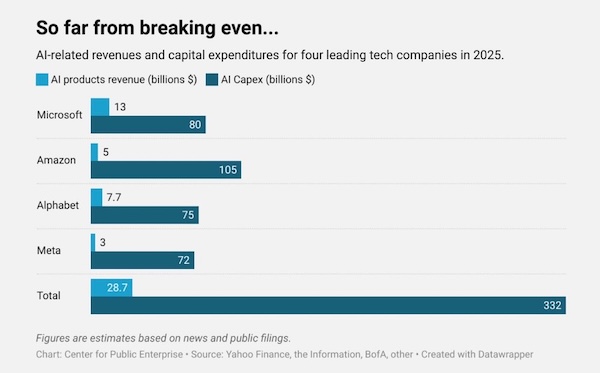A Frankenstein Of Financial Bubbles
Image Source: Unsplash
Below are some of the most interesting things I came across this week.
PODCAST
Paul Kedrosky tells Bloomberg, “For the first time, we combine all the major ingredients of every historical bubble in a single bubble… It’s like we said, ‘You know what would be great? Let’s create a bubble that takes everything that ever worked and put it all in one.’ And that is what we’ve done.”

STAT
Many argue that, unlike the Dotcom bubble, Big Tech stocks today are highly profitable. However, as The Wall Street Journal points out, “OpenAI’s loss in the quarter equates to 65% of the rise in underlying earnings of Microsoft, Nvidia, Alphabet, Amazon and Meta together. That ignores Anthropic, from which Amazon recorded a profit of $9.5B from its holding in the loss-making company in the quarter.”

STAT
And those losses at OpenAI that helping to bolster the profits of Big Tech may, in fact, understate the true nature of the problem. “The apparent gap between revenues and running costs is a lot more than has been reported previously. If the data is accurate, then it would call into question the business model of OpenAI and nearly every other general-purpose LLM vendor,” reports The Financial Times.

LINK
Moreover, meeting the exponentially growing capital needs of the companies working to build out the datacenters at the heart of the AI boom is increasingly becoming an exercise in creative accounting. As The Wall Street Journal reports, “The Hyperion deal is a Frankenstein financing that combines elements of private-equity, project finance and investment-grade bonds. Meta needed such financial wizardry because it already issued a $30B bond in October that roughly doubled its debt load overnight.”

LINK
The widening gap between the expenditures needed to build out AI datacenters and the cash flows generated by the products they enable creates a risk that, as the Center for Public Enterprise reports, “If there is a sudden stop in new lending to data centers, Ponzi finance units ‘with cash flow shortfalls will be forced to try to make position by selling out position’—in other words to force a fire sale—which is ‘likely to lead to a collapse of asset values.'”

More By This Author:
Investor ‘Greed’ Goes Off The Chart
Building Monuments To The Greatness Of Big Tech
Searching For Meaning In Gold’s Scorching Rally - Part 2




